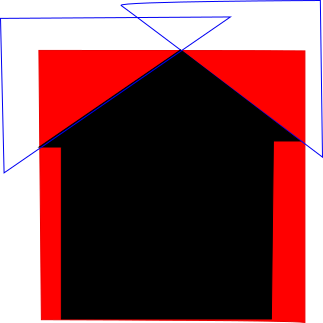Mesh reduction is well known. You have some algorithm for removing faces and vertices while trying to maintain something close to the original shape. This usually doesn't work well if you push it too hard and try for an extreme low-poly version of the mesh.
Has anyone ever looked at this from the other direction? Suppose you take a mesh and enclose it in a bounding box. That's the ultimate "low poly" version. Then you use a simple cutting object, such as a cube or a tetrahedron or a plane, to cut off part of the bounding box. Pick the cut that will remove the most excess volume. Repeat until some error criterion is reached.

Here's the general idea, in 2D. We take the black design and surround it with a red bounding box. Then we clip off sections of the red area, as shown by the blue outlines. The next cut should be the one that removes the most red without removing any black. Here, two cuts would get us roughly the house shape. Enough cuts would get you the original object, but you stop long before that point.
Somebody must have tried this; it's kind of obvious. But I've never seen it done.









